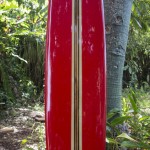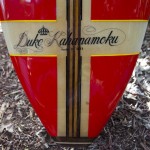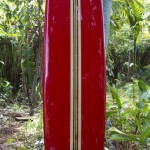Duke Kahanamoku 10′ longboard (mid 1960s)
by
*SOLD, Request to be notified when similar board available | Board Location: Hawaii *Worldwide Shipping Available*
10′ Duke Kahanamoku longboard made in the mid 1960’s. This board has it’s original 15-piece wood fin and double wood tail block.This board was fully restored by a surfboard restoration expert with over 30 years of glassing experience.
If you have any questions or need a shipping quote please leave a comment below and/or visit our Contact Page
Duke Kahanamoku: The long-celebrated father of modern surfing, from Honolulu, Hawaii; an Olympic gold medal swimmer and Hawaii’s beloved ambassador to the world through much of the first half of the 20th century. Kahanamoku was a skilled wave-rider, but his real gift to surfing was the way he presented the sport as something that could be practiced with grace, humor, and generosity. “You know,” he said in 1965, “there are so many waves coming in all the time, you don’t have to worry about that. Take your time—wave come. Let the other guys go; catch another one.” The sport’s greatest shortcoming may be that surfers have for the most part failed to live up to the Kahanamoku ideal.
Kahanamoku was born (1890) and raised in Honolulu, a full-blooded Hawaiian, and the first-born son of a delivery clerk. Five male siblings followed; all were first-rate surfers, swimmers, and paddlers. Surfing, along with other native Hawaiian forms of recreation, had all but vanished at the time of Kahanamoku’s birth, partly because the indigenous population had been decimated by a century’s worth of Western-borne disease, and partly due to the work-not-play influence of homesteading Calvinist missionaries. By the time Kahanamoku was in school, however, agricultural and tourist interests had replaced the missionaries in setting the political and cultural tone in Hawaii, and surfing began to flourish in Waikiki. It soon became the romantic symbol of America’s newest vacation destination.
Kahanamoku was a natural at virtually all water-related activities—bodysurfing, board-surfing, diving, sailing, and outrigger canoe paddling—but he first came to prominence as a short-distance swimmer. In the summer of 1911, at age 20, he broke the American 50-yard record by more than a second, and beat the 100-yard world record by more than four seconds. (Kahanamoku had earlier that year cofounded the Hui Nalu Club, the world’s second surfing organization following the 1908-formed Outrigger Canoe Club.) In the 1912 Olympics, held in Stockholm, Sweden, the 6’1″ 190-pound Duke used the already-famous “Kahanamoku Kick” to set another world record on his way to a gold medal in the 100-meter freestyle; he also won a silver medal in the 200-meter freestyle relay. In the 1920 Olympics in Antwerp, Belgium (World War I forced the cancellation of the 1916 Games), Kahanamoku won gold medals in both the 100-meter freestyle and the 400-meter freestyle relay; in the 1924 Olympics in Paris, the 34-year-old won a silver medal in the 100-meter freestyle. He was called the “human fish” and the “Bronzed Duke,” and at age 42 Kahanamoku swam sprints as fast as when he was 21. In 1925, he made what the Honolulu Star-Bulletin described as a “superhuman rescue act,” pulling eight fishermen out of heavy seas at Newport Beach, California.
Kahanamoku was by then the world’s best-known surfer. In 1910, when virtually all Waikiki surfers were riding near the beach on six- or seven-foot boards, he’d made himself a smooth-riding 10-footer that he could take further offshore to pick up bigger, longer waves. He rode for the most part in an elegant, straight-backed stance, but played to onlookers at times by standing on his head as he approached the beach.
In 1912, while returning from the Olympics, he brought surfing to the American East Coast, with exhibitions in New Jersey’s Atlantic City; in late 1914 and early 1915, Kahanamoku introduced the Hawaiian form of surfing to Australia and New Zealand with demonstrations that attracted thousands; from 1915 to the early ’30s, he helped popularize surfing in Southern California. It was Kahanamoku who inspired Wisconsin-born swimmer Tom Blake to move to California and learn how to surf; Blake later had a profound effect on the sport, inventing the surfboard fin, the hollow board, and surf photography.
Kahanamoku was celebrated for decades as a swimming and surfing hero (one female admirer described him as “the most magnificent human male God ever put on the earth”), and socialized with Charlie Chaplin, John Wayne, Babe Ruth, and other sports and entertainment giants. In 1957, Kahanamoku appeared on the popular NBC show This is Your Life.
Read the full article @ Matt Warshaw’s Encyclopedia of Surfing… http://encyclopediaofsurfing.com/entries/kahanamoku-duke




